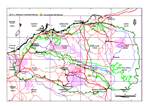Click on images
to enlarge



Photographer: E. Thoma

Photographer: E. Thoma

Photographer: E. Thoma

Photographer: E. Thoma
Botanical name
Acacia aneura var. conifera Randell, J. Adelaide Bot. Gard. 14: 122 (1992)
Common name
Mulga
Note
Acacia aneura and related species form a very complex and polymorphic assemblage of taxa with A. aneura itself the most variable (see Miller et al. 2002 for discussion). These species are currently under review therefore the classification here of Pilbara entities referable to A. aneura is provisional. Currently 10 varieties are recognized within A. aneura (Pedley 2001) of which six appear to occur in the Pilbara. These varieties encompass most of the variation in Mulga in the Pilbara and are the entities upon which this Wattles of the Pilbara treatment of Mulga is based. It is often difficult to distinguish between the varieties, and between A. aneura and related species (especially A. ayersiana and A. paraneura) on account of seemingly intermediate forms. In past literature it is often not possible to know to which of the varieties the information applies. Therefore, we have assembled these data under the heading of A. aneura. The data presented below for A. aneura var. conifera is derived from our field and herbarium studies of only the Pilbara plants of this entity.
Description
Trees to 6-8 m tall, with a single, straight, erect trunk and relatively short, horizontally spreading lateral branches from base to apex (rendering the plants a conifer-like habit). Branchlets resin-ribbed at extremities, with minute, silvery, straight appressed hairs. Brachyblasts absent or few, when present there are 3 or 4 phyllodes in nodose clusters about 3 mm long. New shoots (at least when dry) dark reddish brown. Phyllodes narrowly linear, (30-) 40-70 mm long, 1-2 mm wide, flat, sub-straight to shallowly sigmoid or shallowly to strongly curved, grey-green to sub-glaucous, sometimes slightly kinked at the gland (as in A. paraneura); parallel longitudinal nerves numerous, fine, close together, resinous and of uniform prominence. Inflorescences simple; flowers not seen but judging from fruiting receptacle the spikes are 10-13 mm long; peduncles (few seen) 5-8 mm long. Sepals free, linear-spathulate. Pods 15-45 mm long, 9-12 mm wide, reticulately nerved, minutely appressed -hairy; marginal wing absent or present (see discussion under Variation below). Seeds transverse in the pods, 4-5 mm long, 3-4 mm wide.
Distribution and ecology
Variety conifera is rare in the Pilbara where it known from just two areas, on Juna Downs Station between Tom Price and Newman and from northwest of Paraburdoo. Grows on stony low hills with spinifex ground cover. Pedley (2001) describes var. conifera as being widely distributed (but seemingly not particularly common) from near the west coast of Western Australia through northern South Australia and southern Northern Territory to north-western Queensland, with an isolated occurrence in southwest Queensland; there are some problematic records from the south of the varieties range in the Gairdner-Torrens and Northern Eyre Peninsula regions of South Australia.
Flowering and fruiting period
Flowering specimens from the Pilbara are unknown. Pods with mature seeds have been collected in early November.
Variation
Mature pods on plants from near Paraburdoo have an obscure, transverse reticulum and definitely do not possess an intra-marginal nerve. Pods from plants on Juna Downs, however, are immature but they have a longitudinally oriented reticulum with the nerves rather pronounced, they have an indistinct intra-marginal nerve (wing 1 mm wide).
Taxonomy
The taxonomic status of var. conifera requires further study. Current indications are that the 'conifer-like' growth form that characterizes this entity has arisen independently a number of times in A. aneura. Without knowledge of this character (which can only be determined from observation of the living plants) it is generally difficult to apply this name.
Affinities
In the field at least var. conifera is readily distinguished from all other Pilbara Mulga varieties by its distinctive conifer-like growth form, which is often described as being like a 'Christmas tree'. However, it is not uncommon to see in Mulga populations plants with a 'pseudo-conifer' growth form (especially in var. tenuis) and these should not be confused with 'true' var. conifera. In var. conifera the horizontally spreading lateral branches extend to the top of main stem(s) whereas in plants with a 'pseudo-conifer' growth form the horizontally spreading lateral branches are replaced, at about 2 m about the ground, with distinctly ascending to erect branches. Pressed herbarium specimens are often difficult to positively identify unless growth form characteristics are noted on the label. Nevertheless, in Pilbara plants the relatively short, flat phyllodes help distinguish var. conifera from other varieties of Mulga from that region.
Conservation status
Not considered rare or endangered.
Origin of name
The varietal name refers to the distinctive conifer-like growth form.
References
Miller, J.T., Andrew, R.A. and Maslin, B.R. (2002). Towards an understanding of variation in the Mulga complex (Acacia aneura and relatives). Conservation Science Western Australia 4(3): 19-35.
Pedley, L. (2001). Acacia aneura. pp. 314-322. In: A.E. Orchard and A.J.G. Wilson (eds) Flora of Australia. Volume 11B. pp. 536. (ABRS/CSIRO Publishing: Australia.)
